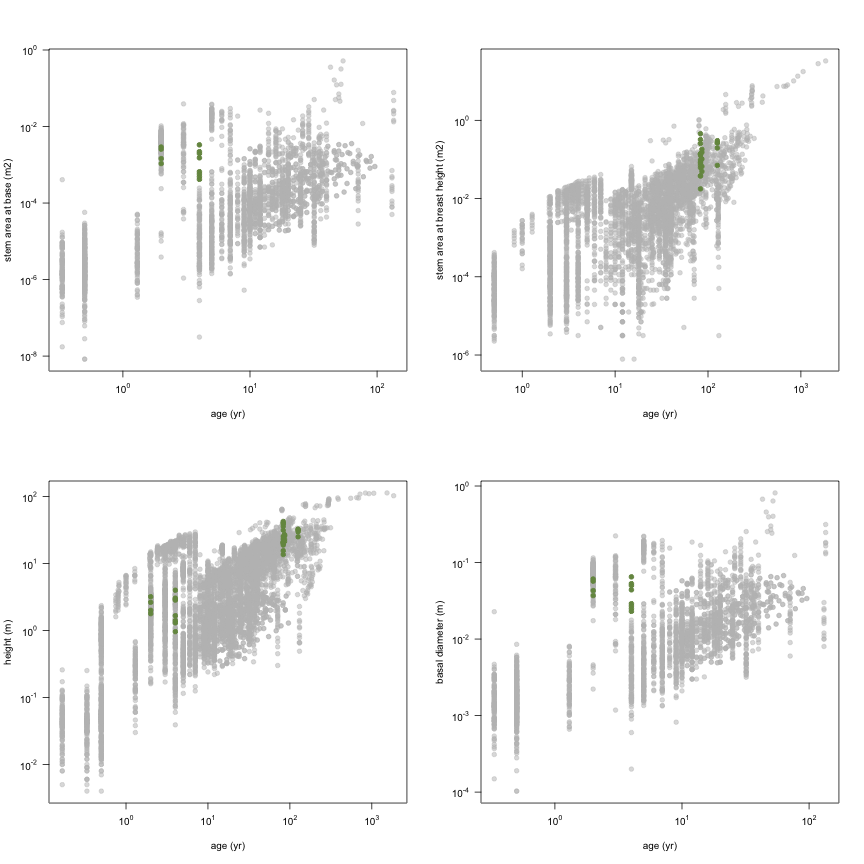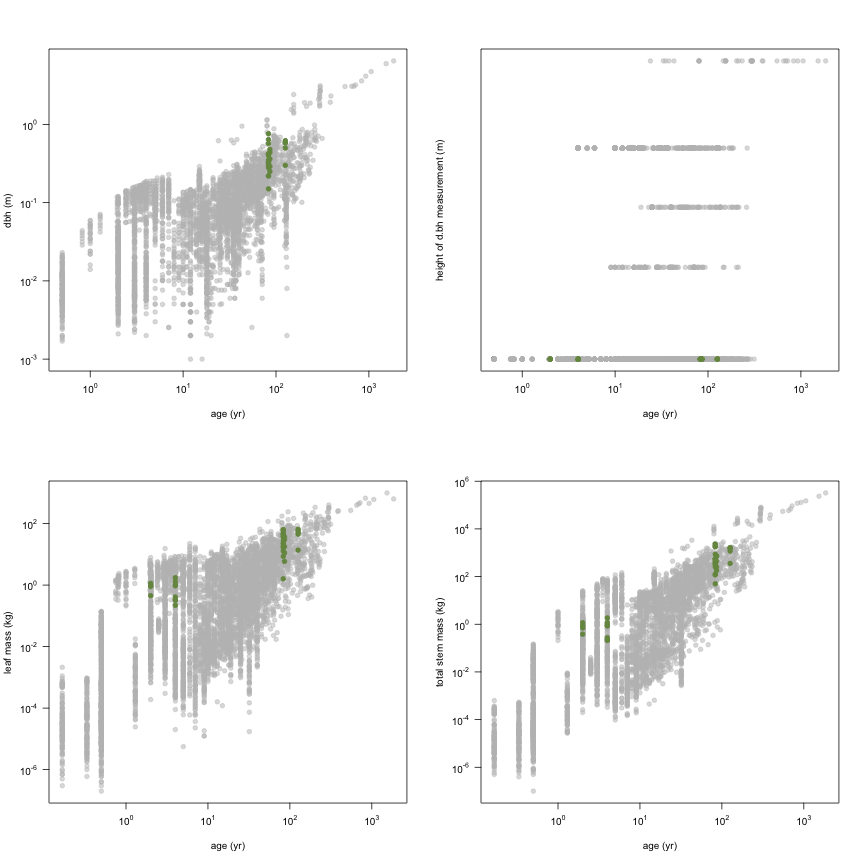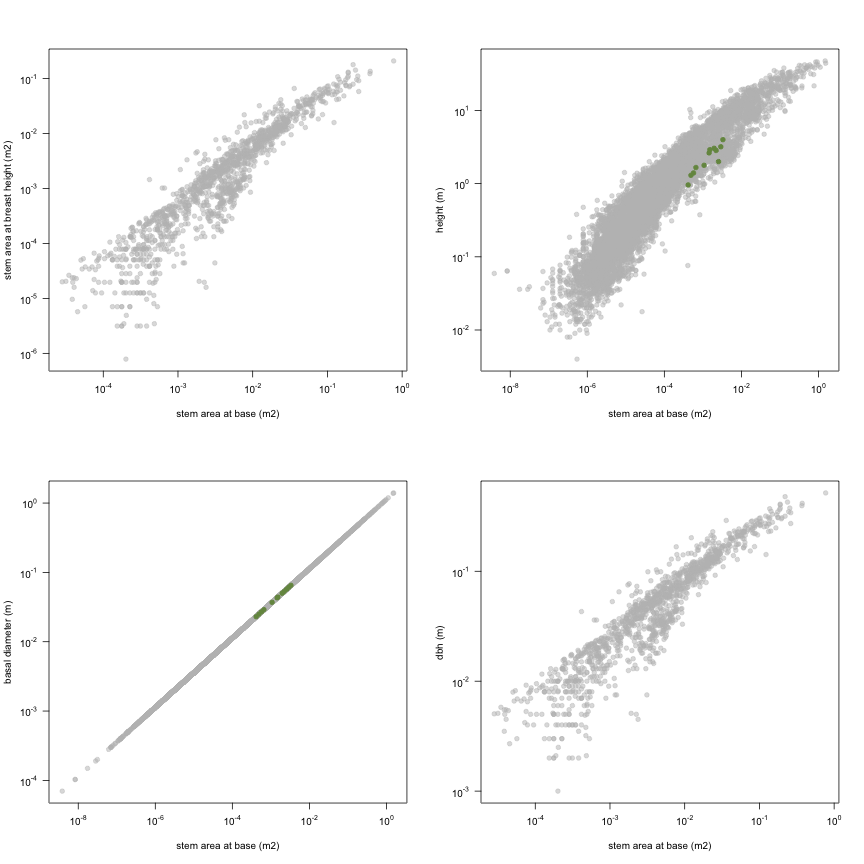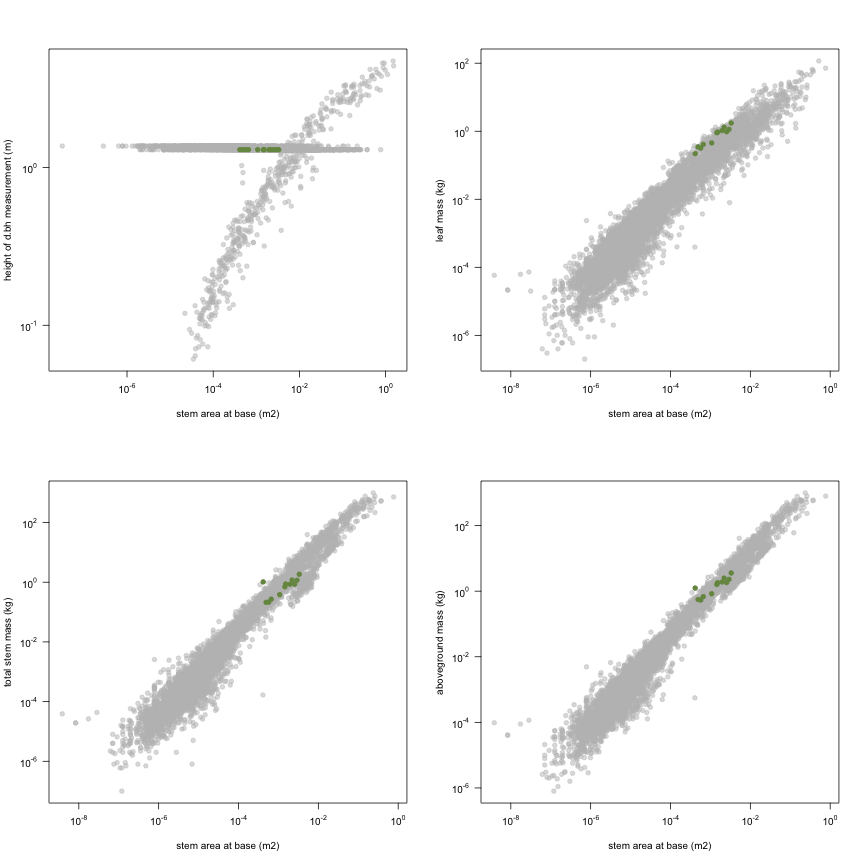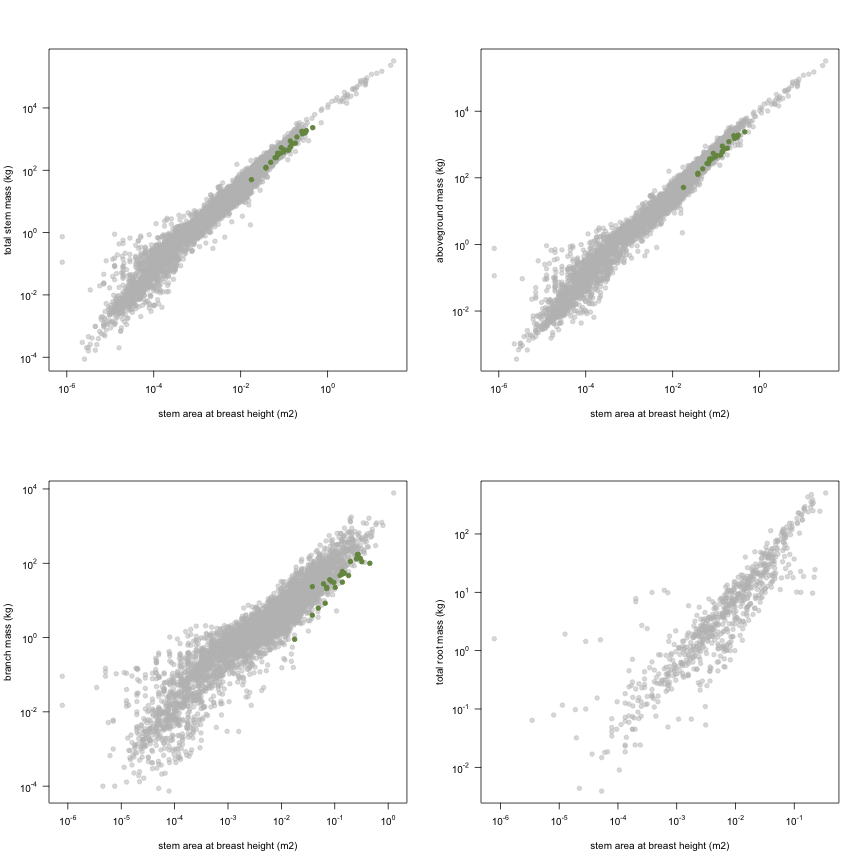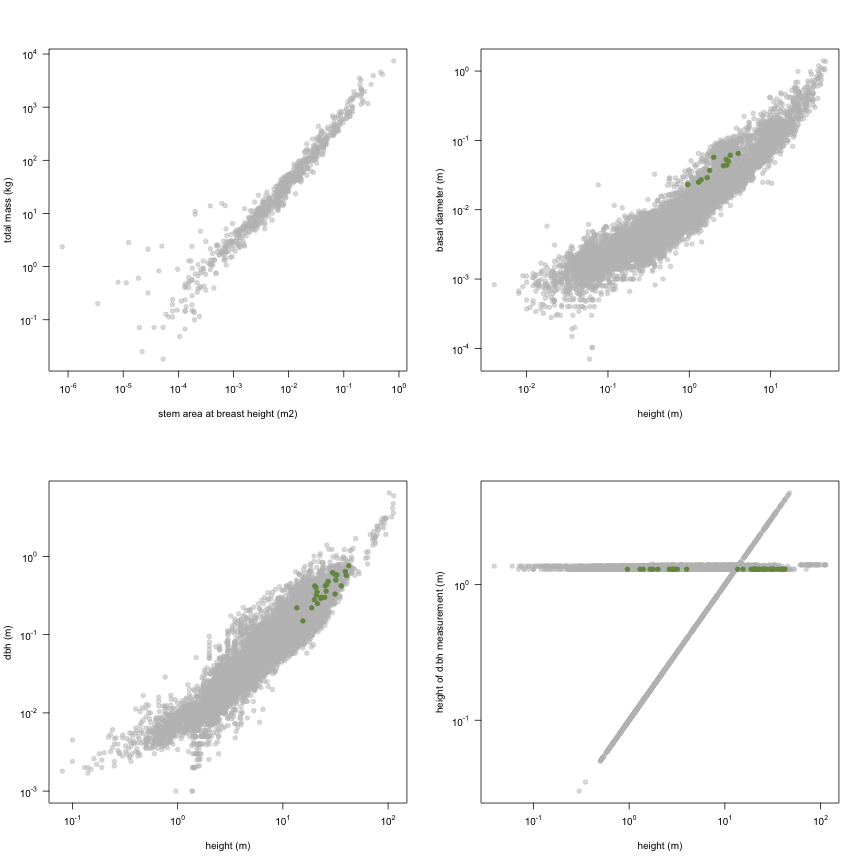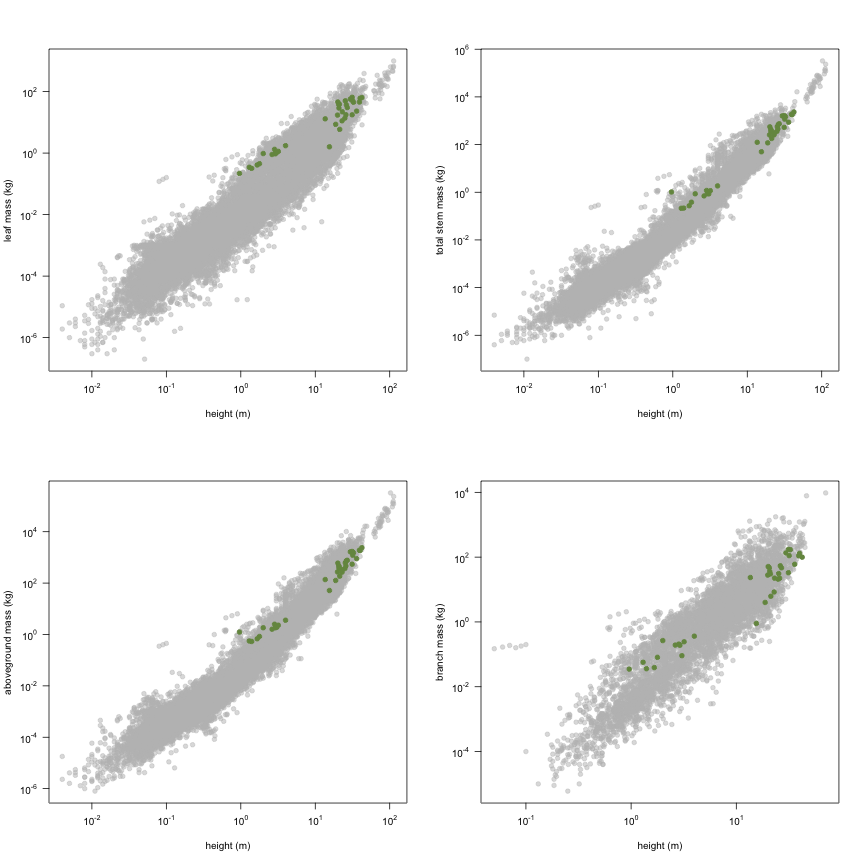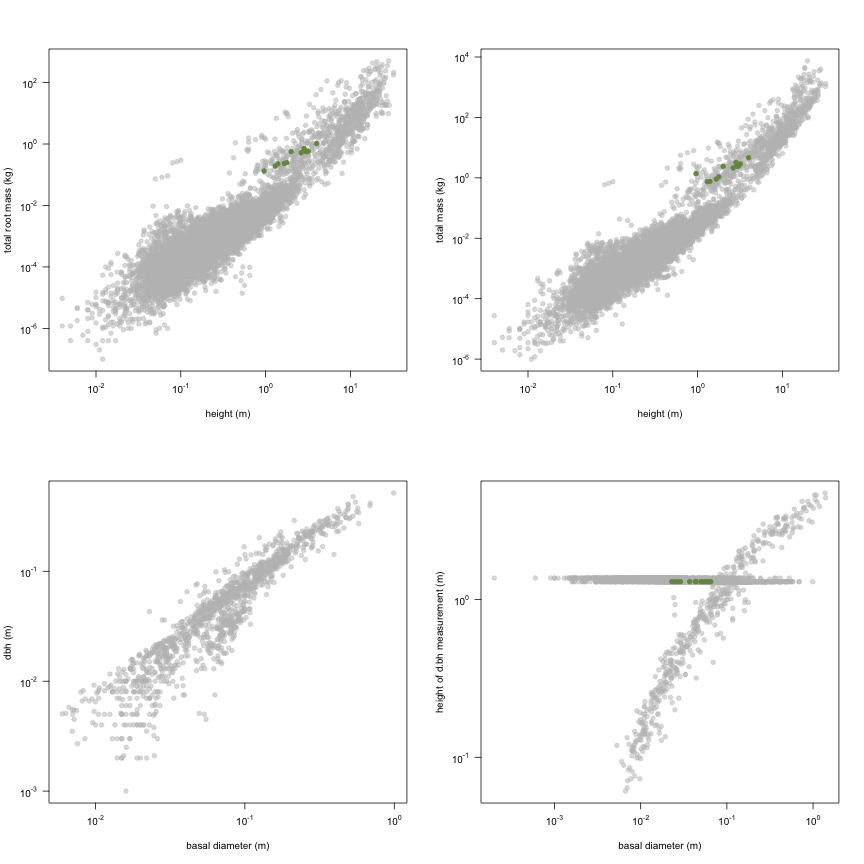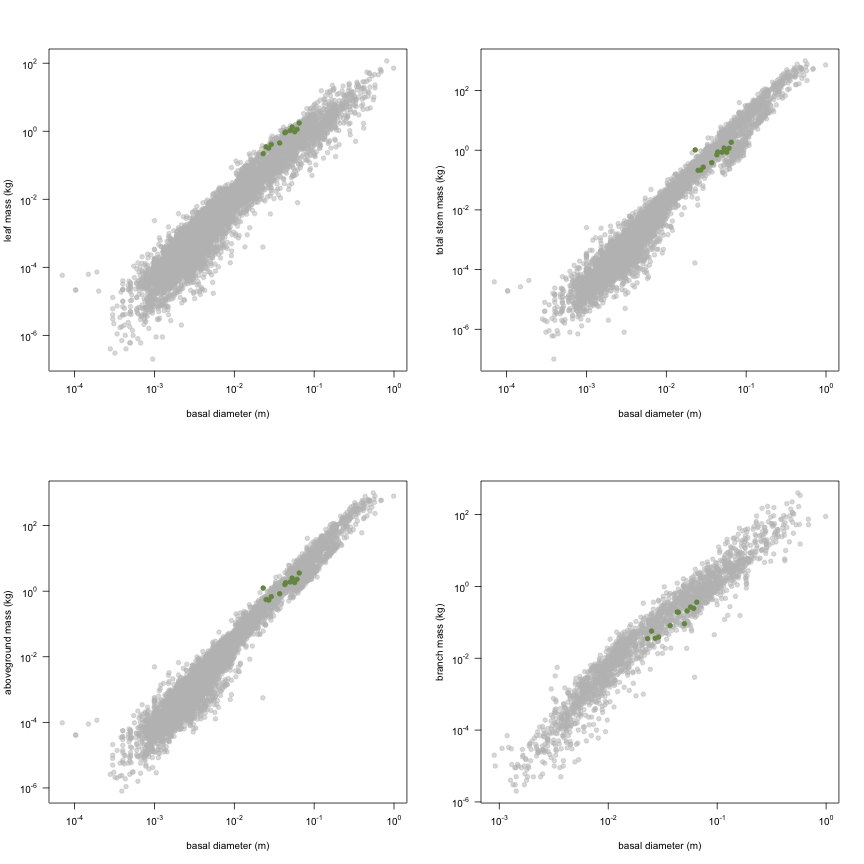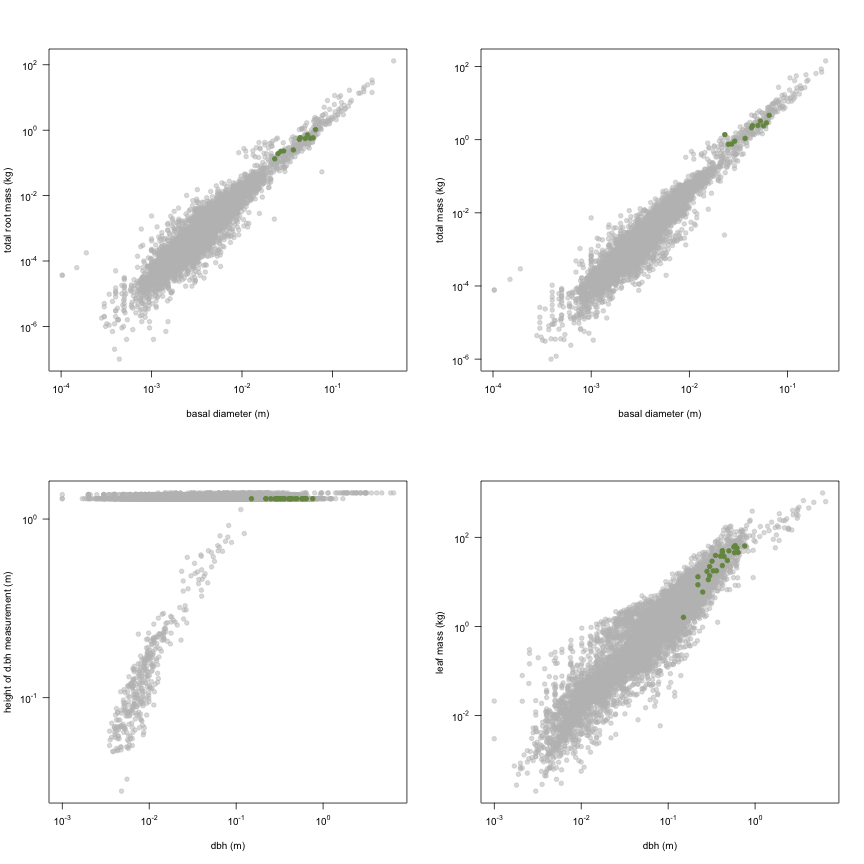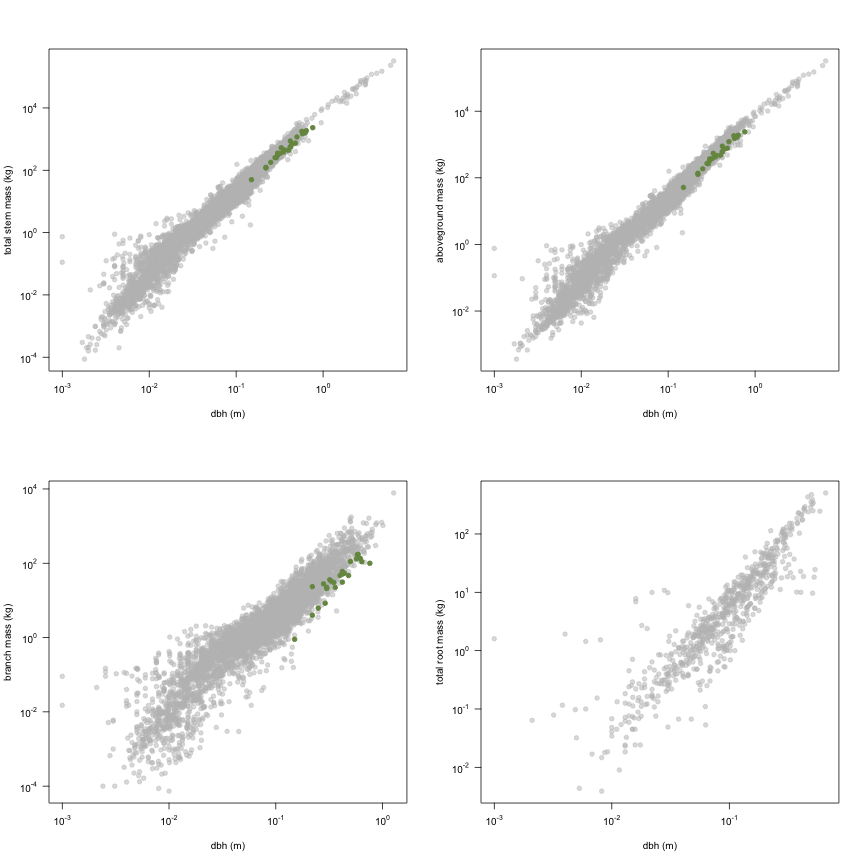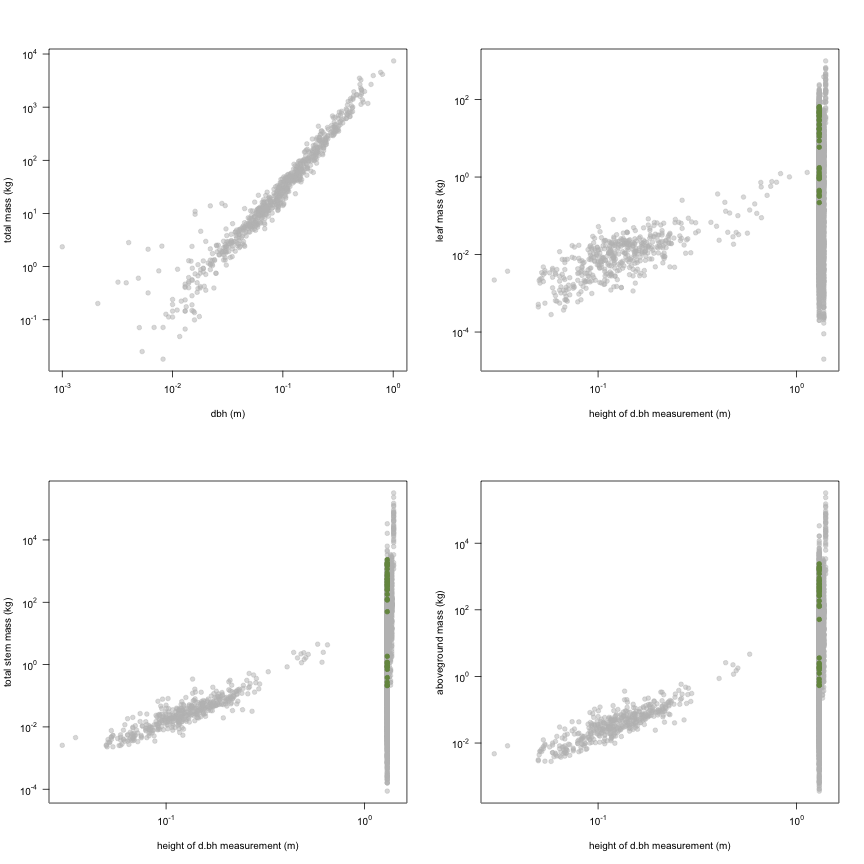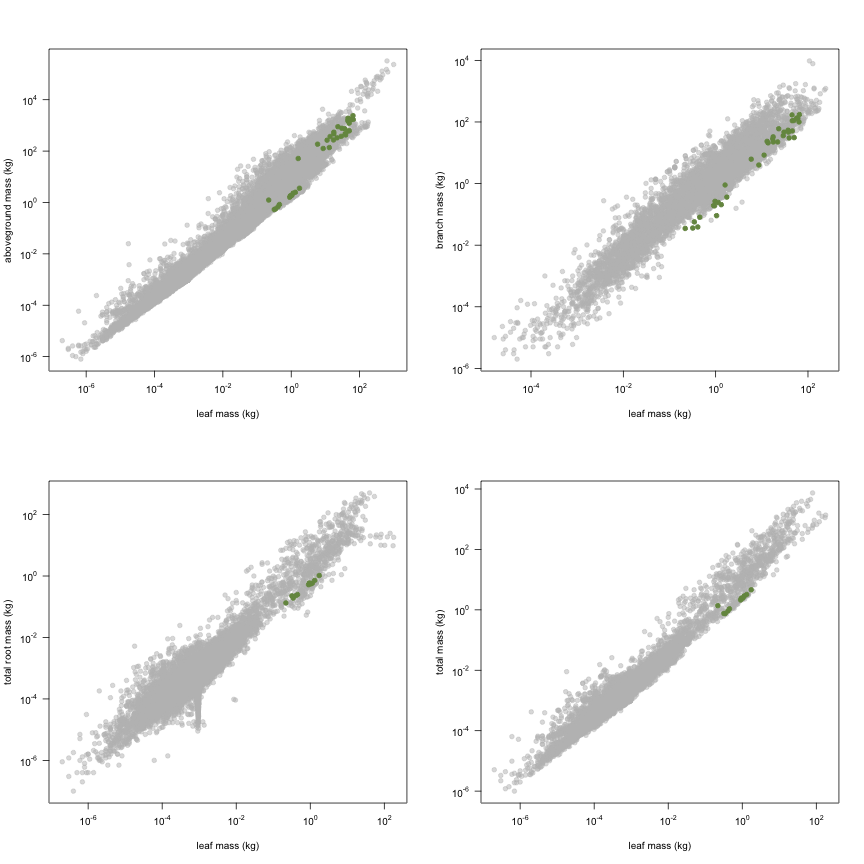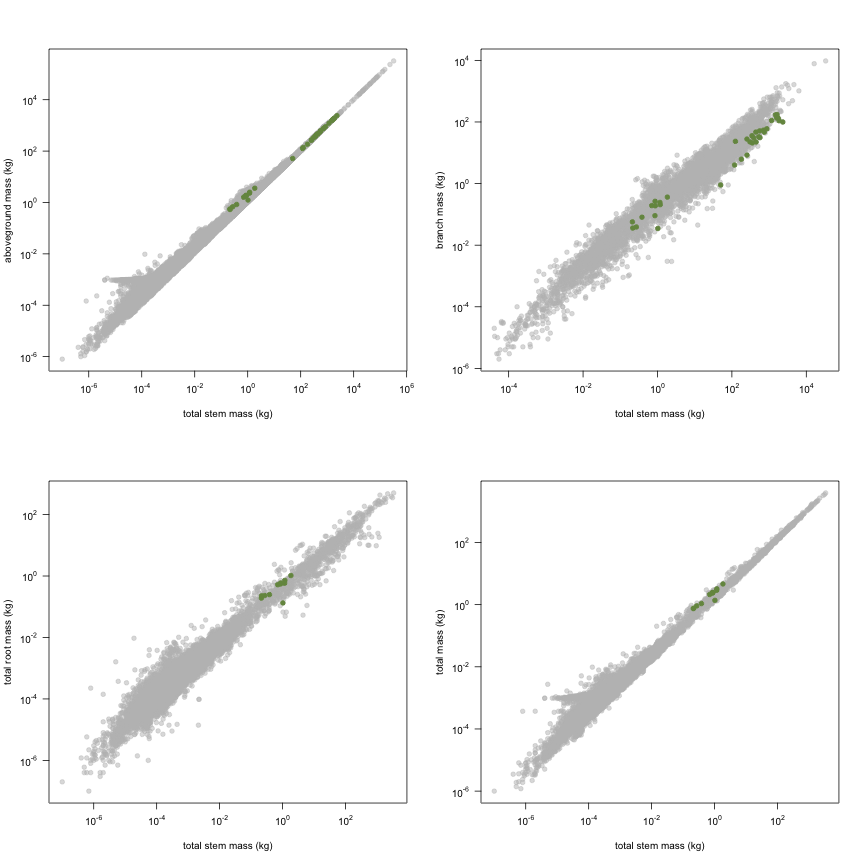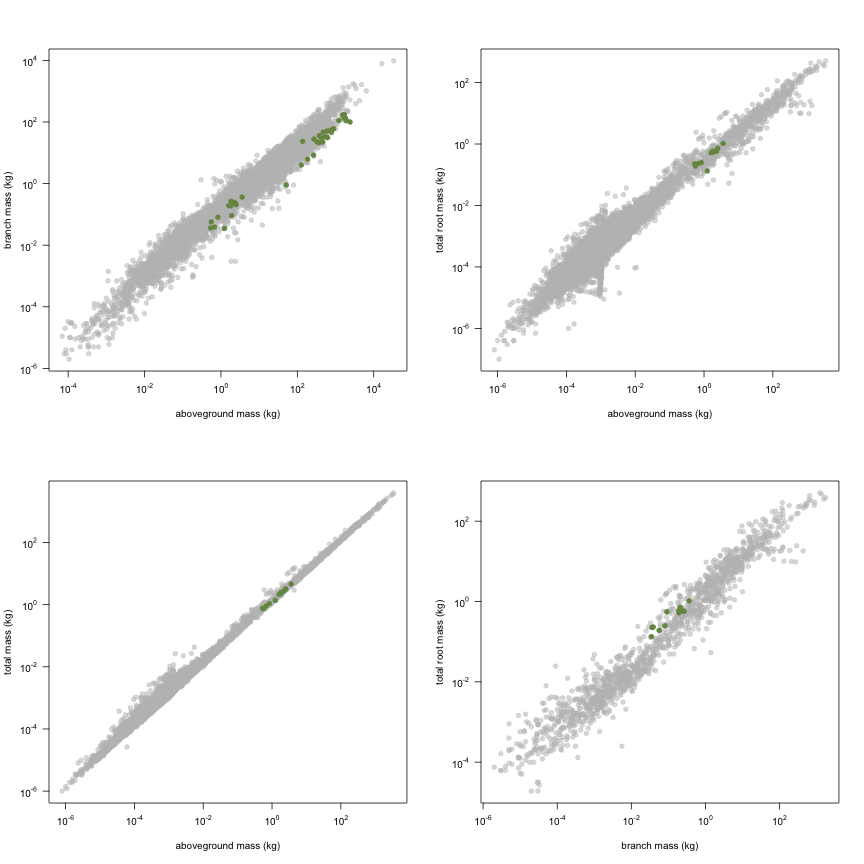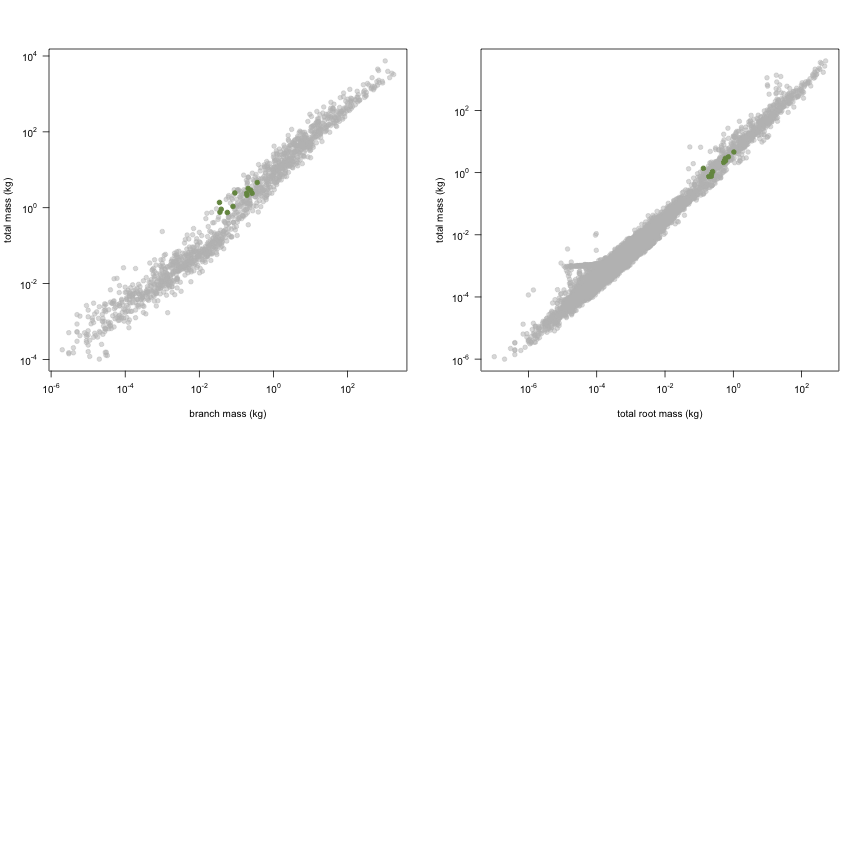-
Notifications
You must be signed in to change notification settings - Fork 19
Tange1995
Data contributor: Takeshi Tange
Email: tange@fr.a.u-tokyo.ac.jp
Address:
- Graduate School of Agricultural and Life Sciences, The University of Tokyo, 1-1-1 Yayoi, Bunkyo-ku, Tokyo, 113-8657, Japan
Citation: Tange T (1995). 'Ecophysiological study on the growth of Cryptomeria japonica planted trees.' Bulletin of the Tokyo University Forests, 93, pp. 65-145.
DOI:
Abstract:
The dataset includes records for 37 individuals from 1 species belonging to 1 family(ies), presenting 1 functional type(s), growing in 1 condition(s) within 1 major type(s) of habitat, with data included for the following variables:
| Variable | Label | Units | N | Min | Median | Max |
|---|---|---|---|---|---|---|
| latitude | Latitude | deg | 37 | 35 | 35 | 35 |
| longitude | Longitude | deg | 37 | 140 | 140 | 140 |
| age | Age | yr | 37 | 2 | 83 | 126 |
| a.stba | Stem area at base | m2 | 12 | 0.00042 | 0.0015 | 0.0033 |
| a.stbh | Stem area at breast height | m2 | 25 | 0.018 | 0.13 | 0.45 |
| h.t | Height | m | 37 | 0.96 | 21 | 42 |
| d.ba | Basal diameter | m | 12 | 0.023 | 0.043 | 0.065 |
| d.bh | Dbh | m | 25 | 0.15 | 0.4 | 0.76 |
| h.bh | Height of d.bh measurement | m | 37 | 1.3 | 1.3 | 1.3 |
| m.lf | Leaf mass | kg | 37 | 0.22 | 17 | 65 |
| m.st | Total stem mass | kg | 37 | 0.21 | 306 | 2332 |
| m.so | Aboveground mass | kg | 37 | 0.54 | 328 | 2396 |
| m.br | Branch mass | kg | 37 | 0.035 | 22 | 174 |
| m.rt | Total root mass | kg | 12 | 0.13 | 0.54 | 1 |
| m.to | Total mass | kg | 12 | 0.75 | 2.3 | 4.6 |
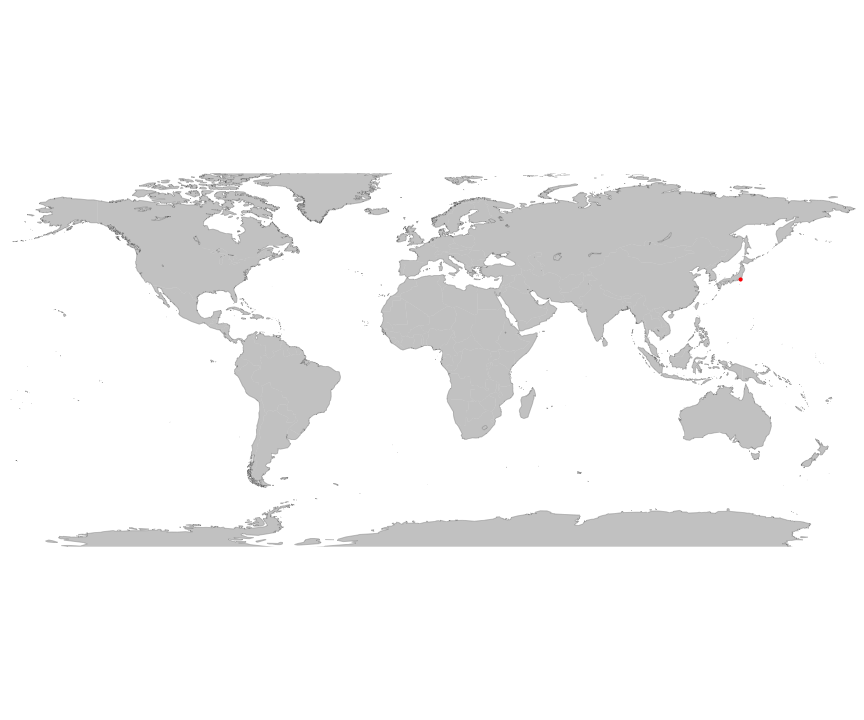
And locally within the country:

The sites sampled are:
| Location | Longitude | Latitude | Vegetation |
|---|---|---|---|
| Japan-Chiba Forest of Tokyo University, Gobozawa-GBU1 | 140.1 | 35.2 | Temperate forest |
| Japan-Chiba Forest of Tokyo University, Gobozawa-GBU2 | 140.1 | 35.2 | Temperate forest |
| Japan-Chiba Forest of Tokyo University, Gobozawa-GBM | 140.1 | 35.2 | Temperate forest |
| Japan-Chiba Forest of Tokyo University, Gobozawa-GBL | 140.1 | 35.2 | Temperate forest |
| Japan-Chiba Forest of Tokyo University, Imasumi-IML | 140.1 | 35.2 | Temperate forest |
| Japan-Chiba Forest of Tokyo University, Imasumi-MR(B)U | 140.1 | 35.2 | Temperate forest |
| Japan-Chiba Forest of Tokyo University, Imasumi-MR(B)L | 140.1 | 35.2 | Temperate forest |
| Japan-Chiba Forest of Tokyo University, Imasumi-NNU | 140.1 | 35.2 | Temperate forest |
| Japan-Chiba Forest of Tokyo University, Imasumi-NNL | 140.1 | 35.2 | Temperate forest |
| Japan-Chiba Forest of Tokyo University, Imasumi-ME(C)U | 140.1 | 35.2 | Temperate forest |
| Japan-Chiba Forest of Tokyo University, Imasumi-ME(C)L | 140.1 | 35.2 | Temperate forest |
The growing conditions of sampled plants was:
| Location | growingCondition |
|---|---|
| Japan-Chiba Forest of Tokyo University, Gobozawa-GBU1 | plantation managed |
| Japan-Chiba Forest of Tokyo University, Gobozawa-GBU2 | plantation managed |
| Japan-Chiba Forest of Tokyo University, Gobozawa-GBM | plantation managed |
| Japan-Chiba Forest of Tokyo University, Gobozawa-GBL | plantation managed |
| Japan-Chiba Forest of Tokyo University, Imasumi-IML | plantation managed |
| Japan-Chiba Forest of Tokyo University, Imasumi-MR(B)U | plantation managed |
| Japan-Chiba Forest of Tokyo University, Imasumi-MR(B)L | plantation managed |
| Japan-Chiba Forest of Tokyo University, Imasumi-NNU | plantation managed |
| Japan-Chiba Forest of Tokyo University, Imasumi-NNL | plantation managed |
| Japan-Chiba Forest of Tokyo University, Imasumi-ME(C)U | plantation managed |
| Japan-Chiba Forest of Tokyo University, Imasumi-ME(C)L | plantation managed |
| Species | Family | Pft |
|---|---|---|
| Cryptomeria japonica | Taxodiaceae | evergreen gymnosperm |
Sampling strategy: Sampling was conducted in the University Forests in Chiba, the University of Tokyo (Tange 1995). Twenty-five trees were felled in old-growth Cryptomeria japonica plantations at Gobozawa (plots GBU1, GBU2, GBM, and GBL, geology: Mane mudstone member) in November 1988 and at Imasumi (plot IML, geology: Kiwada mudstone member) in November 1985. Plots GBU1 and GBU2 were located near the ridge, plot GBM on a middle part of a slope, and plot GBL and IML near the bottom of slopes. Altitude, slope, slope direction, stand age, mean stem diameter, and mean tree height were: GBU1: 270 m, 36 degree, W, 83 years, 28.9 cm, 17.3 m; GBU2: 200 m, 3 degree, W, 83 years, 27.0 cm, 19.8 m; GBM: 205 m, 20 degree, W, 86 years, 39.7 cm, 25.5 m; GBL: 180 m, 5 degree, NW, 83 years, 47.6 cm, 35.2 m; IML: 300 m, 18 degree, E, 122 years, 50.5 cm, 27.6 m. Five trees were cut at ground level from each plot to cover tree size ranges. The sample trees were then treated with the stratified clip technique by cutting them into parts contained in horizontal layers of 0-0.3 m, 0.3-1.3 m, at intervals of 2 m upward in Imasumi. In Gobozawa, horizontal layers were 0-0.3 m, 0.3-1.3 m, at intervals of 4 m up to crown base, and at intervals of 2 m further upward. In addition, 12 trees were felled in young Cryptomeria japonica plantations at Maruyama (plots MR(B)U and MR(B)L, geology: Shiraiwa tuff member, stand age: 2), Ninosawa (plots NNU and NNL, geology: Mane mudstone member, stand age: 4), and at Maezawa (plots ME(C)U and ME(C)L, geology: Kiwada mudstone member, stand age: 4) in January 1986. Plots with U in their names were located near the ridge, and those with L were near the bottom of slopes. Mean stem diameter and mean tree height were: MR(B)U: 2.4 cm, 1.18 m; MR(B)L: 2.7 cm, 1.53 m; NNU: 2.5 cm, 1.15 m; NNL: 4.1 cm, 2.20 m; ME(C)U: 2.9 cm, 1.38 m; ME(C)L: 5.1 cm, 2.40 m. Two trees of average size were sampled from each plot. The sample trees were then treated with the stratified clip technique by cutting them into three parts. Roots including fine roots of the sampled trees from were excavated carefully.
Stem cross sectional area: Estimated from stem diameter.
Height: Measured by measuring tape after sampled trees were cut down.
Biomass: Sample trees in old-growth plantations were divided into each layer and each organs (stem, branches, and leaves) and weighted (Tange 1995). Green branches with diameter > 5 mm were categorized as branches and those =< 5 mm as leaves. Fresh mass of stem, branches, and leaves was converted to dry mass from the ratio of dry to fresh mass. The ratio was estimated from subsamples taken from each tree. For stem, a disk of ca. 5 cm thickness was collected as subsample at the basal end of each horizontal layer. For leaves and branches, subsample was collected from each layer. Various sized branches were included in subsample. Subsamples were weighted for fresh mass, oven-dried at 85 degree C, and weighted for dry mass. Each of three parts of young sample trees were divided into each organs (stem, branches, leaves, and roots), oven-dried, and weighted.
Other variables: Species name and family names were converted by M.I. Ishihara according to the following references: Satake Y, Hara H (1989a) Wild flower of Japan Woody plants I (in Japanese). Heibonsha, Tokyo; Satake Y, Hara H (1989b) Wild flower of Japan Woody plants II (in Japanese). Heibonsha, Tokyo.
This is how the study Tange1995 fits in the entire dataset (grey). each colour represents a species. A legend of species names with colours is included at the end for reports with 1 < n < 20 species.
